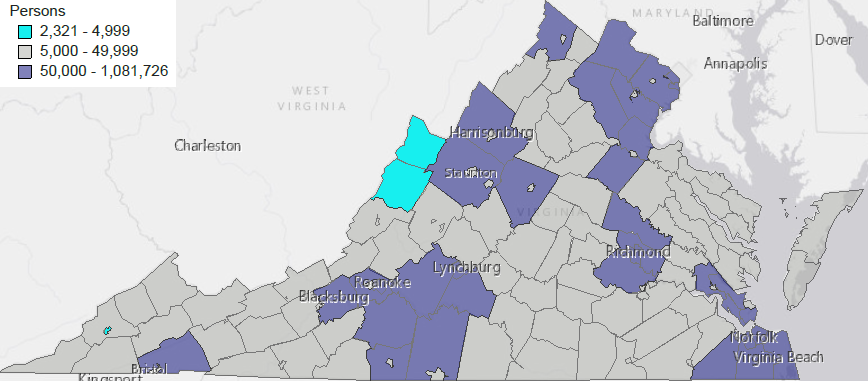
Virginia's local governments vary widely in population
Source: Bureau of Census, Annual Estimates of the Resident Population: April 1, 2010 to July 1, 2016

Virginia's local governments vary widely in population
Source: Bureau of Census, Annual Estimates of the Resident Population: April 1, 2010 to July 1, 2016
The Virginia General Assembly created Dickenson County in 1880, the last county to be formed by subdividing existing counties in the state. Since then, new cities and towns have been created, and mergers of some jurisdictions have created new names for old counties. In 2017, there were 95 counties, 38 independent cities, and 191 towns in the state.1
There is a wide variation in the population totals and population density of the local jurisdictions in Virginia. The 2010 Census counted 2,319 people in Highland County, and 1,081,725 people in Fairfax County. In addition to Highland County, Bath County and the City of Norton also had less than 5,000 residents. 15 jurisdictions had over 100,000 residents - the counties of Spotsylvania, Stafford, Arlington, Henrico, Loudoun, Chesterfield, Prince William, and Fairfax, plus the cities of Hampton, Alexandria, Newport News, Richmond, Chesapeake, Norfolk, and Virginia Beach.2

Virginia's local governments vary widely in population
Source: Bureau of Census, Annual Estimates of the Resident Population: April 1, 2010 to July 1, 2016
In 1634, the General Assembly created exclusive jurisdictional boundaries for units of local government. They were initially called "shires," and are known now as counties. Since Williamsburg was founded in 1699 and obtained a town charter in 1722, the places where people are most-concentrated have obtained charters from the General Assembly to define what authorities have been granted to the local government.
In the 1800's, when agriculture was still the dominant industry, towns and cities were isolated spots in Virginia where there were relatively high population densities. Town and city residents paid higher taxes to support water/sewer systems, roads, police patrols, and other services.
Counties were rural and had low population densities. County governments offered few services and consequently low taxes. When development expanded beyond the boundaries of a town/city and county residents requested an extension of services such as a water line, the town/city typically would annex the area.
When governor and then later via the 1932 Byrd Road Act, Harry Byrd orchestrated a shift in state policies that emphasized the distinction between rural counties and more-developed towns/cities. He eliminated the state tax on real property and transferred responsibility for constructing and maintaining roads to the state. State funding for education and other services was minimized.
The result was that residents in towns/cities, many of which wanted to expand school systems and other services as population increased, had to raise property taxes within their own jurisdiction to fund those services. The rural elite were less supportive of increasing education. If potential farm workers developed skills needed by manufacturers and migrated to urban areas, there might be a shortage of laborers needed to pick apples, tobacco, etc.
The Byrd Organization used various techniques to suppress the vote until the 1960's, disenfranchising the farm workers (especially the black ones) in rural counties. The white farmers who owned land controlled county elections, minimized investment in county schools, and ensured county tax rates stayed low.
Rather than develop county-managed service districts to provide water/sewer services, county officials allowed nearby towns/cities to extend their infrastructure. In the 1930's, the distinction between developed town/city and undeveloped county began to disappear, particularly on the edges of Washington DC. Suburban sprawl extended along Route 1, Route 50, and other highway corridors. Alexandria County (renamed Arlington County in 1920) began to resemble the adjacent cities of Falls Church and Alexandria.
The logical distinction between the level of services provided in towns/cities vs. counties has disappeared in the urban crescent along I-95 and I-64.
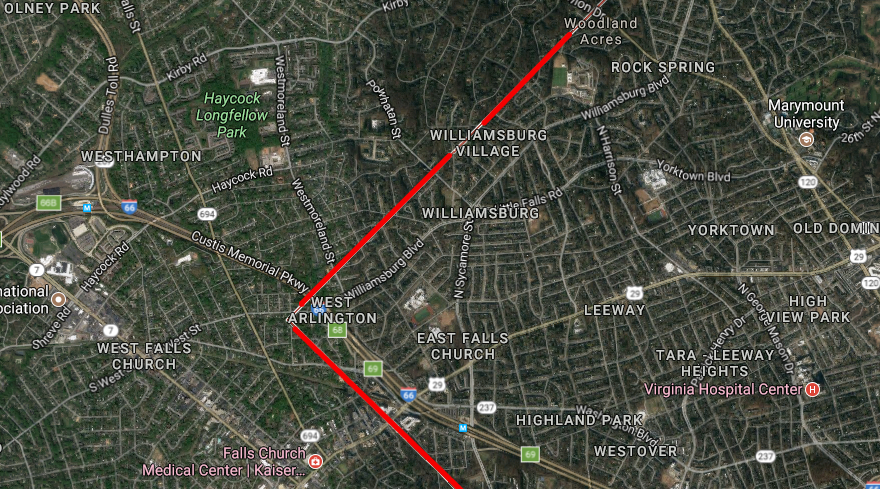
there is no longer a change in the pattern of development between the City of Falls Church and the western edge of Arlington County
Source: Google Maps
Despite the growth of the suburbs, the old political structures and fragmented boundaries still remain. Local jurisdictions continue to use their own policies and procedures, increasing the costs and frustration levels for companies doing business in multiple jurisdictions (especially land developers and builders). Inconsistent planning and land use policies make regional cooperation difficult.
State officials seeking to build roads and transit projects to minimize traffic congestions must factor in the city/county/town boundaries. Any new transportation infrastructure might raise land values and stimulate commercial development in one jurisdiction, at the expense of other jurisdictions. Regional organizations that plan regional transportation projects and set priorities for funding, such as the Hampton Roads Transportation Planning Organization are composed of local officials with local priorities. The decisionmakers do not synchronize their parochial interests easily.
For example, the extension of High Occupancy Toll (HOT) lanes on I-395 north to the Potomac River was blocked for several years by Arlington County's objections. Efforts by Fairfax County and Arlington County to build a light rail system on Columbia Boulevard were derailed when Arlington unilaterally withdrew from the project. Norfolk built a light rail system on an alignment to extend it to Town Center in Virginia Beach, but then Virginia Beach dropped plans for that extension.
One opportunity is to realign boundaries of local government, in order to take advantage of economies of scale and to provide services efficiently. The costs to maintain separate sheriffs, Commissioners of Revenue, county supervisors, and school superintendents could be minimized by merging adjacent counties, especially those with low populations.
The independent cities of Staunton and Waynesboro are completely surrounded by Augusta County, just as the independent cities of Buena Vista and Lexington are completely surrounded by Rockbridge County. Merging them, and other city/county combinations like them, could streamline government operations.
Nonetheless, consolidations of towns, cities, and counties in Virginia are rare. What makes sense economically is different from what makes sense culturally and politically. The strong tradition of "place" in Virginia culture, and the natural desires of local officials to retain their authority, outweigh the campaign promises to reduce waste in government.
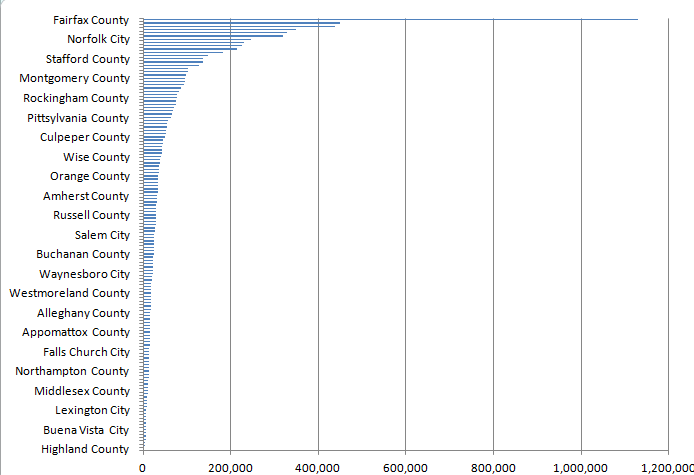
Federal state funding based on population (2013 estimates displayed above) affect the quality/amount of services that can be provided at the local level
Source: Bureau of Census, Annual Estimates of the Resident Population: April 1, 2010 to July 1, 2013
Since 1900, consolidations have occurred three times in Virginia between two independent cities: Richmond-Manchester in 1910, Newport News-Warwick in 1958, and Suffolk-Nansemond in 1974. Town-town mergers include Basic City merging into Waynesboro (1923), North Tazewell merging into Tazewell (1963), and Cambria merging into Christiansburg (1964).
Cities can annex towns, so long as they absorb the entire town. Newport News annexed the Town of Kecoughtan from Elizabeth City County in 1927.3
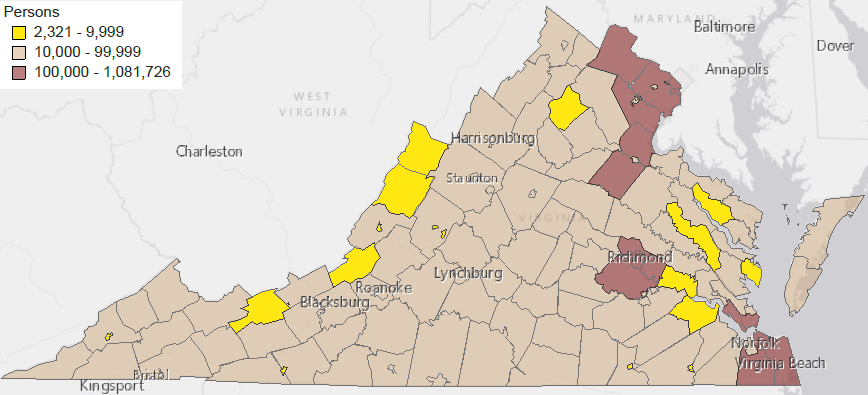
the jurisdictions with the greatest number of residents include both cities and counties
Source: Bureau of Census, Annual Estimates of the Resident Population: April 1, 2010 to July 1, 2016
City-county combinations include the City of Newport News expanding to include the entire county of Warwick in 1958, while the City of Virginia Beach absorbed Princess Anne County in 1963. Also in 1963, the City of South Norfolk merged with Norfolk County to create the new City of Chesapeake.
In other mergers, the Hampton (city), Phoebus (town), and Elizabeth City (county) consolidated into the City of Hampton in 1952. The towns of Holland and Whaleyville merged with Nansemond County to create the City of Nansemond in 1972.
Many mergers have been blocked by the state or rejected by local voters:4
| Units of Government Involved | Proposed Name of Consolidated Government | Year of Rejection |
|---|---|---|
| Hampton (city) Newport News (city) Warwick (city) | City of Hampton Roads | 1956 |
| Richmond (city) Henrico (county) | City of Richmond | 1961 |
| Winchester (city) Frederick (county) | City of Winchester | 1969 |
| Roanoke (city) Roanoke (county) | Name of City to be determined by voters | 1969 |
| Charlottesville (city) Albemarle (county) | Name of City to be determined by voters | 1970 |
| Bristol (city) Washington (county) | Name of City to be determined by voters | 1971 |
| Front Royal (town) Warren (county) | Front Royal - City or County form to be determined by voters | 1976 |
| Pulaski (town) Dublin (town) Pulaski (county) | County of Pulaski | 1983 |
| Staunton (city) Augusta (county) | Consolidated County of Augusta and Tier City of Staunton | 1984 |
| Covington (city) Clifton Forge (city) Alleghany (county) | City of Alleghany Highlands | 1987 |
| Emporia (city) Greensville (county) | City of Emporia | 1987 |
| Roanoke (city) Roanoke (county) | Roanoke Metropolitan Government | 1990 |
| Clifton Forge (city) Alleghany (county) | City of Alleghany | 1991 |
| Bedford (city) Bedford (county) | City of Bedford and Shire of Bedford | 1995 |
One alternative to merger is to abandon a city or town charter. Since 1990, South Boston, Clifton Forge, and Bedford have chosen to become towns, dropping their independent status as cities.
When a town abandons its charter, the town council is abolished and the town taxes are no longer collected; the area once encompassed by the town becomes an unincorporated portion of the county. In 2014, the Town of Columbia in Fluvanna County decided to dissolve, ending its incorporated status and making the county responsible for all municipal services.5
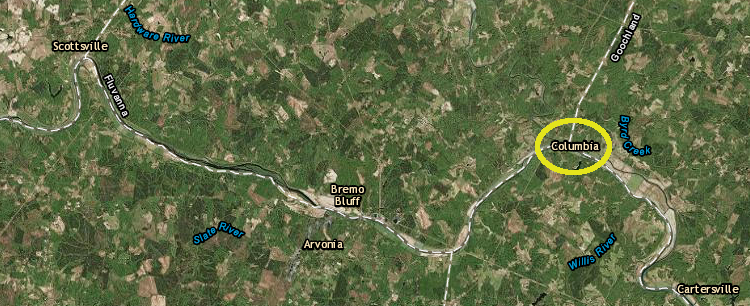
Columbia decided in 2014 to abandon its town charter and become an unincorporated portion of Fluvanna County
Source: ESRI, ArcGIS Online
There are many alternatives for consolidating government services without abolishing a local government unit. Contiguous localities can voluntarily agree to relocate or change their boundary lines, and multiple jurisdictions can sign revenue, tax base and economic growth-sharing agreements.
The Commission on Local Government has highlighted the utility of joint service authorities and special districts to operate combined transportation systems (such as bus lines), public housing, jails, libraries, mental health facilities, etc.6
Federal and state funding is often contingent on regional planning. The state has defined 21 planning districts commissions, and the US Department of Transportation has required the creation of Metropolitan Planning Organizations in urbanized areas with a population over 200,000 people.7
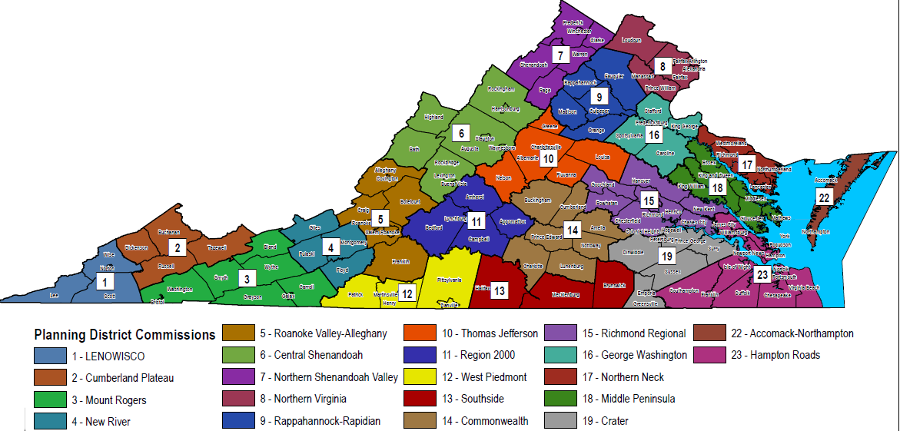
the 21 Planning District Commissions provide a vehicle for 133 counties/cities to coordinate projects and government services
Source: Virginia Department of Housing and Community Development, Map of Virginia's Planning District Commissions
In 2020, Alleghany County and the City of Covington finally agreed to merge their school systems. The county had nearly 2,000 students, while the city had half of that number in its school system.
In Alleghany County, 6-1 votes showed the Board of Supervisors and the school board were strongly in favor of consolidation. The number of students attending county schools had dropped by over 25% since 2013. State funding was reduced accordingly, and the county was faced with a need to continually close schools.
The Covington votes were 3-2 by both the supervisors and the school board. The city's school population had increased by 14% and state aid was climbing, so the pressures to reduce costs were not as great. Opponents of consolidation objected primarily to a perceived loss of city "identity."
Such a merger had been discussed five years earlier, but not implemented in part because city teachers were paid more. The consolidation of city-county school systems in Alleghany County was not unprecedented. The county and the City of Clifton Forge school systems merged in 1983. The Clifton Forge High School building was converted to Clifton Forge Middle School, and later the City of Clifton Forge reverted to town status.
Despite similar economic pressures and school-age population declines in other jurisdictions in rural Virginia, until 2021 no other school systems chose to consolidate after the Alleghany County-Clifton Forge merger.8
Operating joint school systems in Virginia is rare. In 2020, before Alleghany County and Covington City Public Schools, merged, the only two jurisdictions with a consolidated school system were Williamsburg and James City County. The City of Fairfax contracted with the Fairfax County Public Schools to operate its system, but the city retained ownership of the school buildings and a separate school board to set priorities.
After Clifton Forge reverted to town status in 2004, the state adjusted the Local Composite Index for the county for 15 years. That modification to enable extra state funding ended in 2019 after 15 years.
Also in 2019, the General Assembly allocated $400,000 to plan for consolidation of the Covington and Alleghany County schools. The legislature noted that the county had lost 34% of its enrollment, dropping from 2,993 students in 2004 to 1,968 students in 2018. That year the city and county adopted coordinated comprehensive plans to shape future development and local government operations, based on a shared vision:9
The last football game between the two rival high schools was played on September 9, 2022. That game retired the Brackman Trophy, which had been awarded to the winner ever since 1996.
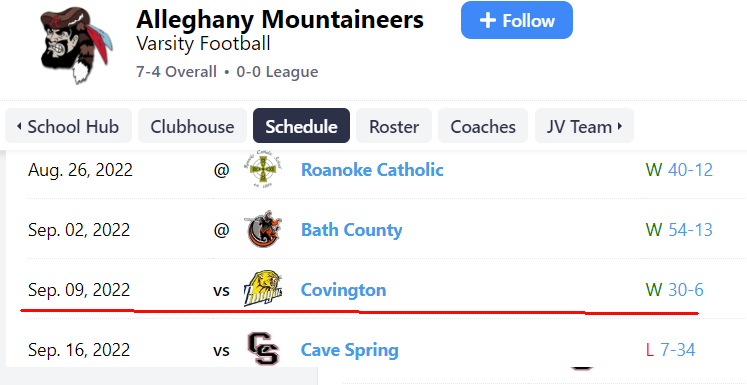
Alleghany County won the last Backyard Brawl football game against Covington, retiring the Brackman Trophy in 2022
Source: ScorebookLive, Alleghany Mountaineers
Starting in August 2023, Covington High School was converted into the system's only middle school; Alleghany High School became the only high school. The colors of the new school mascot, the Alleghany Cougars, included the navy blue of Covington and the Columbia blue from Alleghany. The separate county and city school systems merged in 2022 to form the Alleghany Highlands Public Schools. Reflecting the population disparities, Allehany County had four members on the new school board and the City of Covington had three.
A school board member noted that consolidation would reduce competition for staff but:10
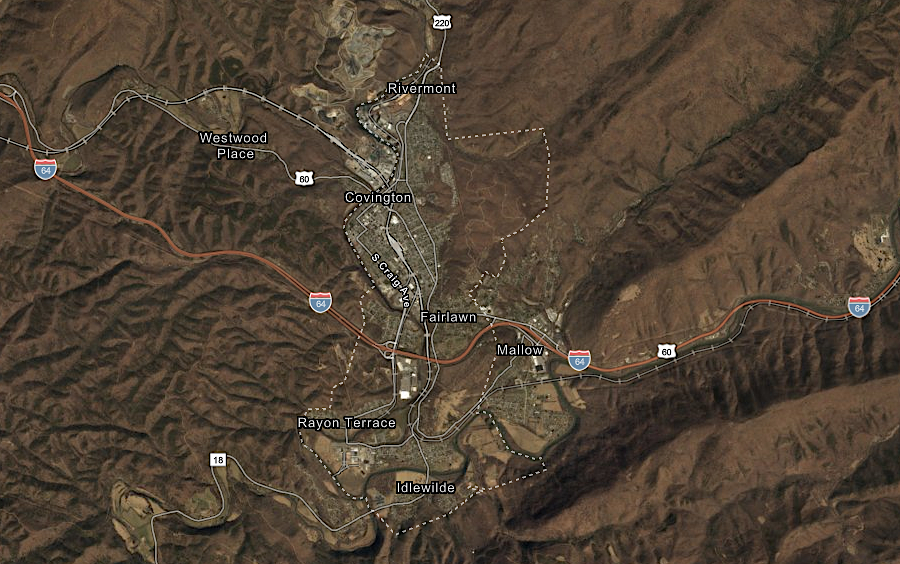
the City of Covington is surrounded by Alleghany County
Source: ESRI, ArcGIS Online